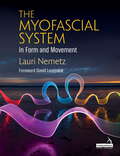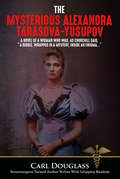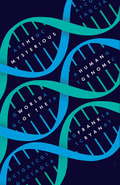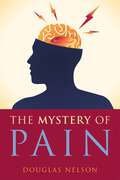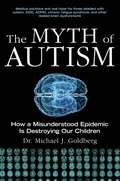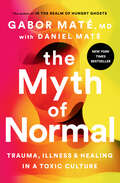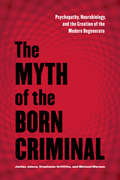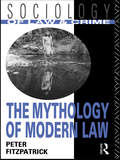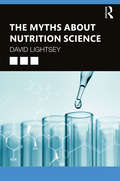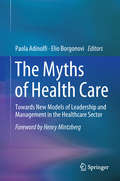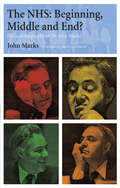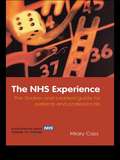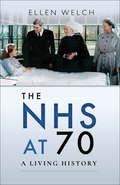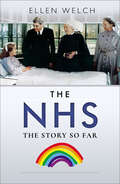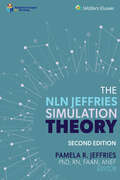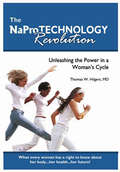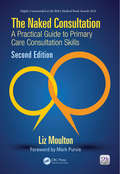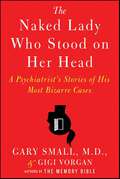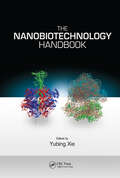- Table View
- List View
The Myofascial System in Form and Movement
by Lauri NemetzThe field of myofascial science is changing rapidly. In The Myofascial System in Form and Movement, Lauri Nemetz invites readers into the rich dialogue around movement, delving into anatomy, concepts of space, and the many other disciplines that are taking interest in the myofascial universe.Nemetz uses insights from our spatial relationship with the world to examine the human body, giving voice to the ideas and work of leaders in this area and prompting readers to develop their own ideas, as well as offering application suggestions to discover in your own body or with others.With an extensive background in art history, myofascial movement, anatomical dissection and more, Nemetz uses her wealth of experience to weave together the many facets of this evolving area in a visually rich and thought-provoking book.
The Mysterious Alexandra Tarasova-Yusupov: A Novel of a Woman who was, as Churchill said, “a riddle, wrapped in a mystery, inside an enigma…”
by Carl DouglassThe Mysterious Alexandra Tarasova-Yusupov is historical fiction about the glory years and the end of Tzarist Russia, and the time when Australia came into its own. It is a tale of swashbuckling heroes, ferocious pirates, and ruthless business tai-pans. The book chronicles the life of a woman who could outcompete them all, but could not conquer her own demons. Alexandra was at once lovable, beguiling, reasonable, and admirable, but also despicable, disenchanting, capricious, and—at times—deplorable. She was always mysterious.
The Mysterious World of the Human Genome
by Frank RyanThe human genome is indeed a mysterious world, but, as this fascinating book shows, its vital secrets are now being uncovered. The latest studies are revealing exciting new discoveries, such as how the DNA and related chemical compounds in our cells work together to direct the processes of life. Scientists are not only unraveling how life evolved in the ancient past, but are also finding the keys to creating a healthier future. How does the minuscule chemical cluster in each of our 100 trillion cells accomplish the amazing feat of creating and maintaining our bodies? Frank Ryan, a physician and an evolutionary biologist, describes the complex ways in which the genome operates as a holistic system and not solely through genes coding for proteins--the building blocks of life. Also involved are elaborate switching mechanisms that regulate and control portions of our DNA, as well as the interplay of retroviruses and bacteria.This groundbreaking book explains that we are on the cusp of an amazing era of disease treatment and eradication.From the Hardcover edition.
The Mystery of Pain
by Douglas NelsonWhy does scratching an itch feel so good? Why is pain from a mosquito bite preferable to the same pain from an unidentified source? Douglas Nelson provides the reader with a comprehensive, practical and highly accessible guide to the scientific understanding of pain. The book explores the different types of pain, providing clear explanations of the processes involved within the body. It examines key issues such as diagnosis and measurement of pain, the placebo effect and fibromyalgia syndrome (FMS), and takes an in depth look at causes and treatment for chronic pain. The book is full of practical advice and small changes one can make to improve the effectiveness of pain treatment. Presented as a personal tutorial for understanding the psychology of pain, this book will be useful for practitioners, patients, and the general reader alike. It will be of particular interest to psychologists, alternative medicine practitioners, massage therapists and psychotherapists.
The Mystery of the Exploding Teeth: And Other Curiosities from the History of Medicine
by Thomas Morris"Delightfully horrifying."--Popular ScienceThis wryly humorous collection of stories about bizarre medical treatments and cases offers a unique portrait of a bygone era in all its jaw-dropping weirdness. A puzzling series of dental explosions beginning in the nineteenth century is just one of many strange tales that have long lain undiscovered in the pages of old medical journals. Award-winning medical historian Thomas Morris delivers one of the most remarkable, cringe-inducing collections of stories ever assembled. Witness Mysterious Illnesses (such as the Rhode Island woman who peed through her nose), Horrifying Operations (1781: A French soldier in India operates on his own bladder stone), Tall Tales (like the "amphibious infant" of Chicago, a baby that could apparently swim underwater for half an hour), Unfortunate Predicaments (such as that of the boy who honked like a goose after inhaling a bird's larynx), and a plethora of other marvels. Beyond a series of anecdotes, these painfully amusing stories reveal a great deal about the evolution of modern medicine. Some show the medical profession hopeless in the face of ailments that today would be quickly banished by modern drugs; but others are heartening tales of recovery against the odds, patients saved from death by the devotion or ingenuity of a conscientious doctor.However embarrassing the ailment or ludicrous the treatment, every case in The Mystery of the Exploding Teeth tells us something about the knowledge (and ignorance) of an earlier age, along with the sheer resilience of human life.
The Myth of Autism: How a Misunderstood Epidemic Is Destroying Our Children
by Elyse Goldberg Michael GoldbergExperts agree that America is in the midst of a disturbing epidemic of what has thus far been diagnosed as autism. In just thirty years autism diagnoses have risen from 1 in 5,000 children to 1 in 110, according to the Centers for Disease Control and Prevention. But in the history of our society there has never been an "epidemic" of any developmental or genetic disorder-it is scientifically impossible. So what is this mysterious affliction known as "autism," and how can we stop it? Dr. Goldberg and his colleagues illustrate why autism cannot be genetic, but is a symptom of a treatable neurological disease that attacks the brain's immune system. Readers will come to understand: Autism is not psychological or developmental, but a medical disease. Autism is caused by a dysfunction in the neuro-immune system and often by secondary neurotropic viruses that impact the neuro-immune system and brain. Illnesses such as autism, ADD/ADHD, and chronic fatigue syndrome all have different "labels" but are actually variations on the same thing: neuro-immune dysfunction syndromes (NIDS). A NeuroSPECT scan is a diagnostic tool which, used in combination with proven therapies and treatments described in this book, is saving lives today, while opening the door to new therapies. What you can do to transform your own life or the lives of your loved ones. Dr. Goldberg believes that in order to save the next generation of children from the incurable stigma of an autism diagnosis, we must quickly realize that all of these disorders are the result of a curable disease process.
The Myth of Autism: How a Misunderstood Epidemic Is Destroying Our Children, Expanded and Revised Edition
by Michael J. GoldbergExperts agree that America is in the midst of a disturbing epidemic of what has thus far been diagnosed as autism. In just thirty years autism diagnoses have risen from 1 in 5,000 children to 1 in 110, according to the Centers for Disease Control and Prevention.But in the history of our society there has never been an "epidemic" of any developmental or genetic disorder-it is scientifically impossible. So what is this mysterious affliction known as "autism," and how can we stop it? Dr. Goldberg and his colleagues illustrate why autism cannot be genetic, but is a symptom of a treatable neurological disease that attacks the brain's immune system. Readers will come to understand that Autism is not psychological or developmental, but a medical disease, Autism is caused by a dysfunction in the neuro-immune system and often by secondary neurotropic viruses that impact the neuro-immune system and brains, illnesses such as autism, ADD/ADHD, and chronic fatigue syndrome all have different "labels" but are actually variations on the same thing: neuro-immune dysfunction syndromes (NIDS), and what you can do to transform your own life or the lives of your loved ones."Dr. Goldberg's knowledge base is greater than anyone else's in this treatment area. He is the best expert in this field, in my opinion. I could have taken my son to any autism doctor in the world and I chose Dr. Goldberg."--Bruce L. Russell, MD, FAAFP
The Myth of Normal: Trauma, Illness, and Healing in a Toxic Culture
by Gabor Maté MDThe instant New York Times bestsellerBy the acclaimed author of In the Realm of Hungry Ghosts, a groundbreaking investigation into the causes of illness, a bracing critique of how our society breeds disease, and a pathway to health and healing.In this revolutionary book, renowned physician Gabor Maté eloquently dissects how in Western countries that pride themselves on their healthcare systems, chronic illness and general ill health are on the rise. Nearly 70 percent of Americans are on at least one prescription drug; more than half take two. In Canada, every fifth person has high blood pressure. In Europe, hypertension is diagnosed in more than 30 percent of the population. And everywhere, adolescent mental illness is on the rise. So what is really &“normal&” when it comes to health?Over four decades of clinical experience, Maté has come to recognize the prevailing understanding of &“normal&” as false, neglecting the roles that trauma and stress, and the pressures of modern-day living, exert on our bodies and our minds at the expense of good health. For all our expertise and technological sophistication, Western medicine often fails to treat the whole person, ignoring how today&’s culture stresses the body, burdens the immune system, and undermines emotional balance. Now Maté brings his perspective to the great untangling of common myths about what makes us sick, connects the dots between the maladies of individuals and the declining soundness of society—and offers a compassionate guide for health and healing. Cowritten with his son Daniel, The Myth Of Normal is Maté&’s most ambitious and urgent book yet.
The Myth of the Born Criminal
by Jarkko Javala Michael Maraun Stephanie GriffithsBy some estimates, there are as many as twelve million psychopaths in the United States alone. Cold-blooded, remorseless, and strangely charismatic, they commit at least half of all serious and violent crimes. Supposedly, most serial killers are psychopaths, as, surprisngly, are large numbers of corporate executives. They seem to be an inescapable, and fascinating, threat in our midst.But is psychopathy a brain disorder, as many scientists now claim? Or is it just a reflection of modern society's deepest fears? The Myth of the Born Criminal offers the first comprehensive critique of the concept of psychopathy from the eighteenth-century origins of the born-criminal theory to the latest neuroimaging, behavioural genetics, and statistical studies. Jarkko Jalava, Stephanie Griffiths, and Michael Maraun use their expertise in neuropsychology, psychometrics, and criminology to dispel the myth that psychopathy is a biologically-based condition. Deconstructing the emotive language with which both research scientists and reporters describe the psychopaths among us, they explain how the idea of psychopathy offers a comforting neurobiological solution to the mystery of evil.A stunning merger of rigorous science and clear-sighted cultural analysis, The Myth of the Born Criminal is for anyone who wonders just what truth - or fiction - lurks behind the study of psychopathy.
The Mythology of Modern Law (Sociology of Law and Crime)
by Peter FitzpatrickThe Mythology of Modern Law is a radical reappraisal of the role of myth in modern society. Peter Fitzpatrick uses the example of law, as an integral category of modern social thought, to challenge the claims of modernity which deny the relevance of myth to modern society.
The Myths About Nutrition Science
by David LightseyMany nutrition science and food production myths and misconceptions dominate the health and fitness field, and many athletes and active consumers unknowingly embrace a myriad of what can be deemed “junk science” which has now infiltrated many related science fields. Consumers simply have no reliable source to help them navigate through all the hype and fabrication, leaving them vulnerable to exploitation. The aim of The Myths About Nutrition Science is, then, to address the quagmire of misinformation which is so pervasive in this area. This will enable the reader to make more objective, science-based lifestyle choices, as well as physical training or developmental decisions. The book also enables the reader to develop the necessary critical thinking skills to better evaluate the reliability of the purported “science” as reported in the media and health-related magazines or publications. The Myths About Nutrition Science provides an authoritative yet readily understandable overview of the common misunderstandings that are commonplace within consumer and athlete communities regarding the food production process and nutrition science, which may affect their physical development, performance, and long-term health.
The Myths of Health Care: Towards New Models Of Leadership And Management In The Healthcare Sector
by Elio Borgonovi Paola AdinolfiThis provocative appraisal unpacks commonly held beliefs about healthcare management and replaces them with practical strategies and realistic policy goals. Using Henry Mintzberg's "Myths of Healthcare" as a springboard, it reveals management practices that undermine care delivery, explores their cultural and corporate origins, and details how they may be reversed through changes in management strategy, organization, scale, and style. Tackling conventional wisdom about decision-making, cost-effectiveness, service quality, and equity, contributors fine-tune concepts of mission and vision by promoting collaboration, engagement, and common sense. The book's multidisciplinary panel of experts analyzes the most popular healthcare management "myths," among them: #65533; The healthcare system is failing. #65533; The healthcare system can be fixed through social engineering. #65533; Healthcare institutions can be fixed by bringing in the heroic leader. #65533; The healthcare system can be fixed by treating it more as a business. #65533; Healthcare is rightly left to the private sector, for the sake of efficiency. The Myths of Health Care speaks to a large, diverse audience: scholars of all levels interested in the research in health policy and management, graduate and under-graduate students attending courses in leadership and management of public sector organization, and practitioners in the field of health care.
The NHS - Beginning, Middle and End?: The Autobiography of Dr John Marks
by John MarksJohn Marks is something of a national treasure. Warm, funny, passionate, opinionated and occasionally contrary, he is a man whose life for more than 40 years marched in beat with that of the National Health Service. There is scarcely a medical issue or controversy in which John Marks was not involved. Abortion law reform, the doctors' 1970s revolt against the General Medical Council, the foundation of the Royal College of General Practitioners, countless NHS reorganizations, and the bloody battle over NHS pay beds and the pay of junior doctors are just a sample.Then there was the fierce, principled battle over how the medical profession and the public should respond to the terror of a new disease - AIDS. And the great war that was fought over the Conservatives introduction of market forces into the NHS in the late 1980s and early 1990s - an approach to running the NHS that lives on, reincarnated, under the current Labor government.In all of these John Marks played more than a walk-on part. In many he was a principal actor. For anyone wanting fully to understand the BMA's role in all this, this book is thus required reading. But it is much more than just a dry history of times past. It is laced with anecdote, from the horrifying to the hilarious, and on to high politics. John Marks' account of his life and times provides the tale of a warm, human, liberal and occasionally buccaneering man whose passion for life and causes leaves even those who do not always agree with him eager to count him among their friends.
The NHS Budget Holder's Survival Guide
by David BaileyFirst Published in 2018. Routledge is an imprint of Taylor & Francis, an Informa company.
The NHS Experience: The 'Snakes and Ladders' Guide for Patients and Professionals
by Hilary CassThe NHS Experience is an accessible and engaging guide for all those journeying through the NHS, whether as patients, carers or professionals. It draws on the experience of staff and families at Great Ormond Street Hospital to provide good practice guidance for both users and providers of health care. Based on the successful Snakes and Ladders drama programme developed at Great Ormond Street Hospital, this unique book uses the story of Daniel, a fictional child with the life-limiting disease cystic fibrosis, to provide insight into the enormous challenges faced by patients, their families and the professionals involved in their care. Asking difficult questions about how we can improve the NHS experience for everyone at the front line, Daniel’s story builds on information from a wealth of sources to highlight: the practical, ethical, resource and financial dilemmas integral to the NHS the vital issues around communication, trust, management of clinical errors, consent, shared decision-making and bereavement the realities of fragmented care, bed shortages, uncertain diagnoses, and complex and difficult treatment choices. This is a book that should be read by all healthcare professionals and everyone who uses the NHS.
The NHS IT Project: The Biggest Computer Programme in the World... Ever!
by Sean BrennanThe emphasis on primary care in health service development requires both academics and professionals involved in research to apply the highest standards in qualitative and quantitative methodology. This book provides accurate and up to date information in an easy to follow and clear way. Guidance is given on appropriate methods specialist advice and where to find it. All chapters include exercises to relate the reader's own experiences and review understanding. Primary Care Research series is aimed at developing the knowledge expertise and skills of all practitioners in primary care. Each book is based on contributions from experts in their field and is supported by practical facts personal insight support and advice. They enable all primary care practitioners to realise the potential of exploring information used in everyday working practice.
The NHS at 70: A Living History
by Ellen WelchAt midnight on 5th July 1948, the National Health Service was born with the founding principle to be free at the point of use and based on clinical need rather than on a persons ability to pay. Seventy years since its formation, these core principles still hold true, although the world we now live in is a very different place to the post war era in which it was formed, and the long term sustainability of the service in its current form is questionable.This book traces the history of our health service, from Victorian healthcare in the early 20th century, through a timeline of change to the current day, comparing the problems and illnesses of 1948 to those we face seventy years later. Politics, funding, and healthcare systems around the world are demystified and we present case studies, views and snapshots from history from people who have experienced our changing NHS.
The NHS: The Story So Far
by Ellen WelchA history of Britain’s healthcare system, from the Victorian era to the post-World War II beginnings of the NHS to the Coronavirus pandemic.The Coronavirus pandemic in 2020 has changed life as we know it and thrust the NHS into the spotlight. A nation in lockdown has adorned windows with rainbows and stepped onto doorsteps every Thursday to celebrate the people who are risking their lives by turning up to work. But as the grim reports of deaths from the disease cumulate, along with stories of insufficient protective equipment for staff, there is hope that the crisis will raise awareness and bring change to the way the NHS and its people are treated.At midnight on 5 July 1948, the National Health Service was born with the founding principal to be free at the point of use and based on clinical need rather than on a person’s ability to pay. Over seventy years since its formation, these core principals still hold true, but the world has changed. Persistent underfunding has not kept pace with increased demand for healthcare, leading to longer waiting times, staffing shortages and low morale.This book traces the history of our health service, from Victorian healthcare and the early 20th century, through a timeline of change to the current day, comparing the problems and illnesses of 1948 to those we face today. Politics and funding are demystified and the effects of the pandemic are discussed, alongside personal stories from frontline staff and patients who have experienced our changing NHS.“Ellen's book takes us on an emotional journey through the history of our beloved NHS. This should be compulsory reading for anyone who thinks the NHS is safe in the hands of anyone but the Labour Party. Absolutely enthralling.” —Books Monthly
The NHS: The Story So Far
by Ellen WelchA history of Britain’s healthcare system, from the Victorian era to the post-World War II beginnings of the NHS to the Coronavirus pandemic.The Coronavirus pandemic in 2020 has changed life as we know it and thrust the NHS into the spotlight. A nation in lockdown has adorned windows with rainbows and stepped onto doorsteps every Thursday to celebrate the people who are risking their lives by turning up to work. But as the grim reports of deaths from the disease cumulate, along with stories of insufficient protective equipment for staff, there is hope that the crisis will raise awareness and bring change to the way the NHS and its people are treated.At midnight on 5 July 1948, the National Health Service was born with the founding principal to be free at the point of use and based on clinical need rather than on a person’s ability to pay. Over seventy years since its formation, these core principals still hold true, but the world has changed. Persistent underfunding has not kept pace with increased demand for healthcare, leading to longer waiting times, staffing shortages and low morale.This book traces the history of our health service, from Victorian healthcare and the early 20th century, through a timeline of change to the current day, comparing the problems and illnesses of 1948 to those we face today. Politics and funding are demystified and the effects of the pandemic are discussed, alongside personal stories from frontline staff and patients who have experienced our changing NHS.“Ellen's book takes us on an emotional journey through the history of our beloved NHS. This should be compulsory reading for anyone who thinks the NHS is safe in the hands of anyone but the Labour Party. Absolutely enthralling.” —Books Monthly
The NLN Jeffries Simulation Theory (Nln Ser.)
by Pamela JeffriesThe NLN Jeffries Simulation Theory, Second Edition establishes the substantive foundation essential for research, education, and practice, and advances knowledge in the area of simulation. Created through a systematic process involving robust research and literature review, along with nursing perspectives from those immersed in simulations, this work can be an effective tool or guide to implementation as well as further research. This Second Edition provides an updated review of the theory, which explains the phenomenon of simulation, presents an updated systematic review of the theoretical constructs and uses of the theory, and highlights future research needs in the area of clinical simulation. This mid-range theory provides a way to study the phenomenon of simulation that can facilitate the exploration of best practices, outcomes, and system change through research and development that will contribute further to the discovery of new knowledge and practices.
The NaPro Technology Revolution: Unleashing the Power in a Woman's Cycle
by Thomas W. HilgersDr. Thomas W. Hilgers draws on decades of medical experience to provide educational and revolutionary insights into the world of women's health. The NaPro Technology Revolution provides real solutions to real problems such as infertility, repetitive miscarriage, menstrual cramps, postpartum depression, PMS, prematurity prevention, ovarian cysts, hormonal abnormalities, irregular/abnormal bleeding, chronic discharges, polycystic ovarian disease, and family planning. Hilgers sheds light on abnormal ovarian function, an issue that millions of women unknowingly suffer from. His methods have proven to assist infertile couples nearly three times more successfully than those who use In Vitro Fertilization, without the dangers of early abortions, frozen embryos, or high rates of multiple pregnancy. The NaProTechnology Prematurity Prevention Program cuts the rate from the national 12.7% to 7%. The NaPro Technology Revolution discusses what every woman has a right to know about her body, her health, and her future!
The Naked Consultation: A Practical Guide to Primary Care Consultation Skills, Second Edition (Radcliffe Ser.)
by Liz MoultonDon’t Wait Until Something Goes Wrong to Think About Your Consultation Skills <P><P>Designed specifically for busy health professionals working in primary care, The Naked Consultation: A Practical Guide to Primary Care Consultation Skills covers all aspects of the primary care consultation in a clear, concise, and highly readable manner. The book begins by breaking the primary care consultation into its components, making it easier to focus on particular areas and practise skills such as encouraging patients to explain what’s wrong, summarising and reflecting, and giving information to patients. The book then describes how to effectively use educational tools—such as videoing, random case analysis, problem case debriefing, and feedback—to improve consultations. It also explains in detail how to demonstrate proficient consultation skills in the Membership of the Royal College of General Practitioners (MRCGP) exam and the importance of these skills in appraisal/revalidation. <P><P>Certified for continuing professional development (CPD®) by The CPD Certification Service, this fully updated and revised Second Edition incorporates new thinking and consultation models, including the 6 S model and the new doctor, patient, illness model. It also provides detailed analysis of the latest Royal College of General Practitioners (RCGP) assessment tools, such as the clinical skills assessment exam (CSA) and the consultation observation tool (COT). <P><P>Complete with illuminating case studies, photocopiable forms, and a jargon-busting appendix, The Naked Consultation: A Practical Guide to Primary Care Consultation Skills, Second Edition offers valuable insight into the key phases of the primary care consultation, the best features of common consultation models, and the real-world application of popular consultation techniques.
The Naked Lady Who Stood on Her Head: A Psychiatrist's Stories of His Most Bizarre Cases
by Gigi Vorgan Gary Small MDA psychiatrist recounts some of his most intriguing cases from his more than twenty-year career in this captivating memoir.“Stories of human behavior at its most extreme. . . . With humor, compassion, empathy, and insight, Small searches for and finds the humanity that lies hidden under even the most bizarre symptoms.” —Daniel H. Pink, author of Drive and A Whole New MindTrue stories are more bizarre than any fiction, and Dr. Gary Small knows this best. After thirty distinguished years of psychiatry and groundbreaking research on the human brain, Dr. Small has seen it all—now he is ready to open his office doors for the first time and tell all about the most mysterious, intriguing, and bizarre patients of his career.The Naked Lady Who Stood on Her Head is a spellbinding record of the doctor's most bewildering cases, from naked headstands and hysterical blindness to fainting schoolgirls and self-amputations. It is an illuminating journey into the mind of a practicing psychiatrist and his life in medicine as it evolves over time—a behind-the-scenes look at the field and a variety of mental diseases as they've never been seen or diagnosed before. You'll find yourself exploring the puzzling eccentricities that make us human.Often funny, sometimes tragic, and always compelling, Dr. Small takes you on a tour of his career that moves from the halls of a crowded inner-city Boston emergency room to the multimillion-dollar ski lodges of the nation's elite. In between, Dr. Small introduces a strange cast of true-life characters and conditions, while dealing with mysterious hysterical blindness, a man convinced that his penis is shrinking, secret double lives, and frighteningly psychotic romantic desires. His career and personal life come full circle when his own mentor becomes his patient, making Small realize that no one is beyond mental exploration—not even himself.“A remarkable achievement . . .uncannily transports the reader into a heretofore unfamiliar world of mental illness. Reading it will fascinate you, inspire you, and teach you more about other people and yourself than you ever thought you knew.” —Sonja Lyubomirsky, author The How of Happiness and professor of psychology, UC Riverside“I found it hard to put this treasure of a book down, and still now reflect on the various lives [they] have so vividly shared through these thoughtful lessons in wisdom and what it means to be human.” —Daniel J. Siegel, MD, author of Mindsight: The New Science of Personal Transformation and professors of psychiatry at UCLA
The Naked Truth: Young, Beautiful, and (HIV) Positive
by Courtney E. Martin Marvelyn BrownThe surprisingly hopeful story of how a straight, nonpromiscuous, everyday girl contracted HIV and how she manages to stay upbeat, inspired, and more positive about life than ever beforeAt nineteen years of age, Marvelyn Brown was lying in a stark white hospital bed at Tennessee Christian Medical Center, feeling hopeless. A former top track and basketball athlete, she was in the best shape of her life, but she was battling a sudden illness in the intensive care unit. Doctors had no idea what was going on. It never occurred to Brown that she might be HIV positive.Having unprotected sex with her Prince Charming had set into swift motion a set of circumstances that not only landed her in the fight of her life, but also alienated her from her community. Rather than give up, however, Brown found a reason to fight and a reason to live. The Naked Truth is an inspirational memoir that shares how an everyday teen refused to give up on herself, even as others would forsake her. More, it's a cautionary tale that every parent, guidance counselor, and young adult should read.
The Nanobiotechnology Handbook
by Yubing XieA thorough overview of nanobiotechnology and its place in advances in applied science and engineering, The Nanobiotechnology Handbook combines contributions from physics, bioorganic and bioinorganic chemistry, molecular and cellular biology, materials science, and medicine as well as from mechanical, electrical, chemical, and biomedical engineering to address the full scope of current and future developments. World-class experts discuss the role of nanobiotechnology in bioanalysis, biomolecular and biomedical nanotechnology, biosensors, biocatalysis and biofuel, and education and workforce development. It includes downloadable resources that contain all figures in the book.The book begins with discussions of biomimetic nanotechnology, including a comprehensive overview of DNA nanostructure and DNA-inspired nanotechnology, aptamer-functionalized nanomaterials as artificial antibodies, artificial enzymes, molecular motors, and RNA structures and RNA-inspired nanotechnology. It shows how nanotechnology can be inspired by nature as well as adverse biological events in diagnostic and therapeutic development. From there, the chapters cover major important and widely used nanofabrication techniques, applications of nanotechnology for bioprocessing followed by coverage of the applications of atomic force microscopy (AFM), optical tweezers and nanofluidics as well as other nanotechnology-enabled biomolecular and cellular manipulation and detection. Focusing on major research trends, the book highlights the importance of nanobiotechnology to a range of medical applications such as stem cell technology and tissue engineering, drug development and delivery, imaging, diagnostics, and therapeutics. And with coverage of topics such as nanotoxicity, responsible nanotechnology, and educational and workforce development, it provides a unique overview and perspective of nanobiotechnology impacts from a researcher’s, entrepreneur’s, economist’s and educator’s point of view. It provides a resource for current applications and future development of nanobiotechnology.
